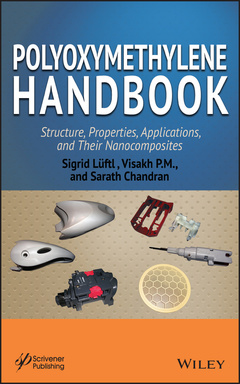Polyoxymethylene Handbook Structure, Properties, Applications and their Nanocomposites Polymer Science and Plastics Engineering Series
Auteurs : Lüftl Sigrid, P. M. Visakh, Chandran Sarath

An excellent, unique, and up-to-date reference book on polyoxymethylene, its compounds, and nanocomposites, specifically dealing with synthesis, characterization, processing, morphology, and applications
Polyoxymethylene Handbook: Structure, Properties, Applications, and Their Nanocomposites summarizes many of the state-of-the-art technological and research accomplishments in the area of polyoxymethylene (POM). It discusses in length the polymerization and manufacture of polyoxymethylene and various types of additives, as well as the structure and crystallization behavior of POM and its thermal, physical, mechanical, flame retardant, chemical, electrical, and optical properties. The environmental impact of POM is also addressed.
The 15 chapters in the handbook are written by prominent researchers from industry, academia, and government/private research laboratories across the globe. Because so few books have ever been published on polyoxymethylene, the handbook is a very valuable reference tool that truly serves as a ?one stop? resource for readers and users seeking solutions to both fundamental and applied problems.
Preface xiii
1 Polyoxymethylene: State of Art, New Challenges and Opportunities 1
Sigrid Luft l and Visakh. P.M.
1.1 Scope 2
1.2 History 2
1.3 Commercial Significance 7
References 13
2 Polymerization and Manufacture of Polyoxymethylene 21
Johannes Karl Fink
2.1 Introduction 21
2.2 Monomers 22
2.3 Comonomers 25
2.4 Polymerization and Fabrication 28
2.5 Special Additives 44
References 46
3 Polyoxymethylene Additives 53
Emmanuel Richaud
3.1 Introduction 53
3.2 Antioxidants 54
3.3 Compounds Reacting with Secondary Reaction Products 59
3.4 UV Stabilization 60
3.5 Impact Modifier 65
3.6 Nucleating Agent 67
3.7 Pigments and Dyes 72
3.8 Flame Retardants 75
3.9 Antistatic Agents 79
3.10 Lubricating Agents 80
3.11 Fillers 82
3.12 Processing Aids 90
References 91
Appendix 3.1: List of Stabilizers 100
4 Polyoxymethylene Processing 107
Kinga Pielichowska
4.1 Introduction 107
4.2 Injection Molding 109
4.3 Melt Extrusion 116
4.4 Solid-State Extrusion 118
4.5 Extrusion Assisted by Supercritical Carbon Dioxide 120
4.6 Blow Molding 121
4.7 Others Methods 123
4.8 Highly Oriented Products 132
4.9 Recycling of Production Waste 136
4.10 Finishing and Machining of POM 138
4.11 Conclusions 141
References 142
5 Polyoxymethylene Applications 153
Lidia Tokarz, Slawomir Pawlowski and Michal Kedzierski
5.1 Introduction 153
5.2 Automotive Industry, Mechanical Engineering 156
5.3 Electrical and Electronic Industry, Fancy Goods 157
5.4 Medical Applications 158
5.5 Future Trends 160
References 160
6 Structure and Morphology of Polyoxymethylene 163
Maria Raimo
6.1 Introduction 163
6.2 Crystalline Structure of POM: Orthorhombic and Hexagonal Phases 165
6.3 Crystal Structure Determination 170
6.4 Morphology of Orthorhombic and Hexagonal POM 173
6.5 Morphology of Rubber-Modified POM 179
6.6 Structure-Properties Relationships 181
References 186
7 Crystal Structure and Crystallization Behavior of POM and its Microscopically-Viewed Relation with the Physical and Thermal Properties on the Basis of X-ray Scattering, Vibrational Spectroscopy and Lattice Dynamical Theory 193
Kohji Tashiro
7.1 Introduction 194
7.2 Crystal Structure Analysis of POM 195
7.3 Vibrational Spectra of POM 204
7.4 Structural Evolution in Isothermal Crystallization 207
7.5 Microscopically-Viewed Mechanical Property of POM 216
7.6 Conclusions 223
Acknowledgements 224
References 224
8 Physical Properties of Polyoxymethylene 227
Johannes Karl Fink
8.1 Introduction 227
8.2 Density 228
8.3 Hardness 230
8.4 Heat Capacity 231
8.5 Melt Flow 231
8.6 Water Absorption 235
8.7 Gas Permeability 236
8.8 Specific Absorption 238
References 239
9 POM Mechanical Properties 241
Fahmi Bedoui and Bruno Fayolle
9.1 Short Term Properties 242
9.2 Long-Term Properties 249
9.3 Conclusion 252
Acknowledgement 253
References 253
10 Thermal Properties and Flammability of Polyoxymethylene 257
Vasiliki-Maria Archodoulaki and Sigrid Luft l
10.1 Glass Transition and Melting Temperature 257
10.2 Coefficient of Linear Thermal Expansion 260
10.3 Thermal Conductivity and Specific Heat 260
10.4 HDT and Vicat 261
10.5 Thermo-Oxidative Degradation Behavior and Aging 261
10.6 Testing of Long-Term Heat Aging 266
10.7 Flammability 267
10.8 Hot Sterilization 270
References 271
11 Chemical Resistance of Polyoxymethylene 277
Sigrid Luft l and Emmanuel Richaud
11.1 Intoduction 277
11.2 Degradation and Oxidation Mechanisms in POM 278
11.3 Resistance to Chemicals 283
References 295
12 The Electrical Response of Polyoxymethylene (POM) 301
D.A. Wasylyshyn
12.1 Introduction 301
12.2 Interactions between POM and Electromagnetic Waves 302
12.3 Interactions between POM and Arc Plasma 313
References 318
13 Electrical and Optical Properties of Polyoxymethylene 321
Natamai Subramanian Muralisrinivasan
13.1 Introduction 321
13.2 Electrical Properties 322
13.3 Optical Properties 327
References 329
14 Nanocomposites of Polyoxymethylene 331
Agnieszka Leszczyñska and Krzysztof Pielichowski
14.1 Introduction 331
14.2 Preparation and Structure of POM Nanocomposites with Different Nanoadditives 332
14.3 Properties of Polyoxymethylene-Based Nanocomposites 347
14.4 POM Blends as Matrices in Nanocomposite Materials 376
14.5 POM Nanostructures - Electrospun POM Nanofibers 381
14.6 Applications of POM-Based Nanocomposites and Future Trends 385
14.7 Conclusions 386
List of acronyms 387
References 388
15 Future, Environmental Impact and Suppliers 399
Takashi Iwamoto and Junzo Masamoto
15.1 Introduction 400
15.2 Developments and Specialty Resins 400
15.3 Safety (Regulation and Approvals) 421
15.4 Environmental Impact 424
15.5 Suppliers and Commercial Grades 426
15.6 Future 426
References 432
Index 435
SIGRID LÜFTL, PhD,is currently involved in researching the influence of artificial aging on the properties of polymer materials. She has worked as a research associate at the Institute of Materials Science and Technology at the Vienna University of Technology.
VISAKH P.M. is a Senior Researcher at the School of Chemical Sciences, Mahatma Gandhi University, India. He has been invited as a visiting student/researcher to about 15 European universities and is the editor of seven books.
SARATH CHANDRAN is working as a research fellow at the School of Chemical Sciences, Mahatma Gandhi University, India, and as a research fellow at the Centre for Advanced Materials and Industrial Catalysis, RMIT, Australia.
Date de parution : 03-2014
Ouvrage de 464 p.
16.3x24.1 cm



